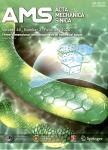Modeling of the role of defects in sintered FeCrAlY foams
在 sintered FeCrAlY 缺点的角色当模特儿起泡沫作者机构:Cambridge University Engineering DepartmentCambridge CB2 1PZUK MOE Key Laboratory of Strength and VibrationSchool of AerospaceXi'an Jiaotong UniversityXi'an 710049China
出 版 物:《Acta Mechanica Sinica》 (力学学报(英文版))
年 卷 期:2007年第23卷第5期
页 面:511-529页
核心收录:
学科分类:07[理学] 070104[理学-应用数学] 0701[理学-数学]
基 金:The project supported by the National Basic Research Program of China(2006CB601202) the National Natural Science Foundation of China(10328203,10572111,10632060) the National 111 Project of China(B06024) the US 0ffice of Naval Research(N000140210117)
主 题:Metal foam Mechanical performance Defect Finite element SEM
摘 要:The metal sintering approach offers a costeffective means for the mass-production of open-cell foams from a range of materials, including high-temperature steel alloys, which offer novel mechanical and acoustic properties. In a separate experimental study, the mechanical properties of open-celled steel alloy (FeCrA1Y) foams have been characterized under uniaxial compression and shear loading. Compared to predictions from established models, a significant knockdown in material properties was observed. This knockdown was attributed to the presence of defects throughout the microstructure that result from the unique fabrication process. In the present paper, the microstructure of sintered FeCrA1Y foams was modeled by using a finite element (FE) model. In particular, microstructural variations were introduced to a base lattice, and the effects on the strength and stiffness calculated. A range of defects identified under scanning electronic microscope (SEM) imaging were considered including broken ligaments, thickness variations, and pore blockages, which are the three primary imperfections observed in sintered foams. The corresponding levels of defect present in the material were subsequently input into the FE model, with the resulting predictions correlating well with experimental data.



